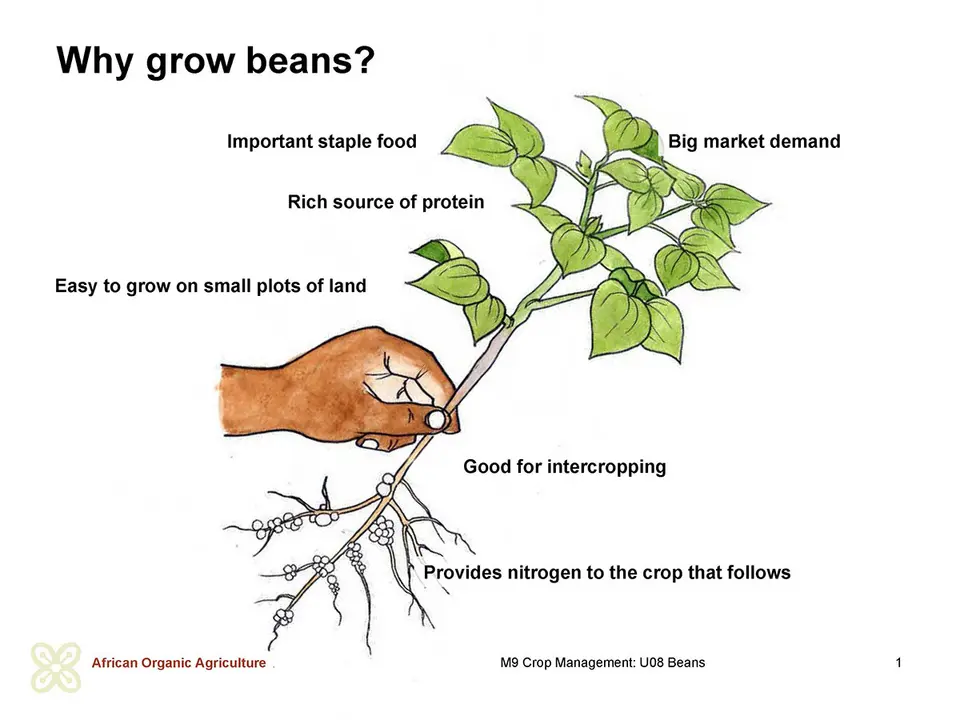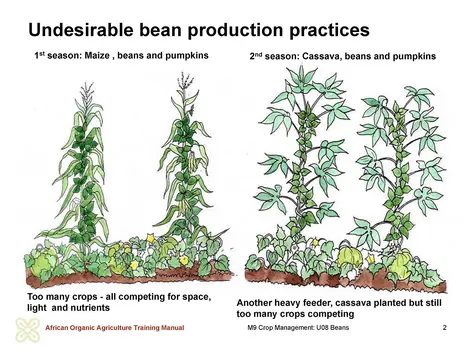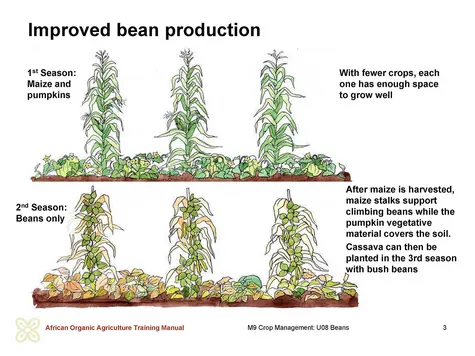Introduction
Common Beans (Phaseolus vulgaris) belong to the very large family of Fabaceae (also called Leguminoseae), which includes food plants such as beans, peas, pulses, peanuts and soybeans. This chapter, however, will focus on the common beans only.
Some important food crops from the Fabaceae family are:
| Genus: Phaseolus (beans) | |
|---|---|
| Common bean | Phaseolus vulgaris |
| Runner bean (scarlet bean) | Phaseolus coccineus |
| Azuki bean | Phaseolus angularis |
| Lima bean (Butter bean) | Phaseolus lunatus |
| Green gram (Mung bean) | Phaseolus aureus |
| Genus: Viceaceae (vetches) | |
|---|---|
| Pea Pisum sativum | |
| Broad bean | Vicia faba |
| Lentil | Lens culinaris |
| Chickpea | Cicer arietinum |
| Cowpea | Vigna sesquipedalis |
| Genus: Glycine | |
|---|---|
| Soybean | Glycine max |
Common beans (Phaseolus vulgaris) can be differentiated into:
a. Dry beans and green beans - Common beans can be grown as dry (shelled) beans or green beans (also called French or haricot beans), whereby green beans are the unripe pods of common beans. Varieties suitable for shelling usually have larger seeds and bigger pods and the shelled seeds can be eaten either fresh or dried. Green beans have fleshy pods and should be harvested before the seeds are fully developed.
b. Indeterminate (climbing) and determinate (bush) beans - The indeterminate growth of climbing beans refers to growth that is not terminated while bush beans grow to approximately 50 cm and can be grown without support. Climbing beans are usually grown on a trellis and can easily grow 3 meters high or more. Because of the bigger plant volume, they have a higher yield potential than bush beans.
Advantages of incorporating beans into a cropping system
An important characteristic of beans, like other legumes too, is their ability to transform atmospheric nitrogen into nitrogen that can be taken up by plants. They do this with the help of Rhizobium bacteria that live in their roots. This property makes beans (and other legumes) an important element in crop rotations. They provide nitrogen not only for themselves, but also for the crops that follow.
The reasons to grow beans on small and medium sized farms are manifold:
- Beans, like other legumes, are a rich source of protein, carbohydrates, minerals and vitamins. Protein content in beans can reach up to 40 %, whereas the protein content of meat is approximately 20 % only.
- Beans are an important staple food in rural Africa and grown widely, only second to maize.
- Beans are relatively easy to grow on small pieces of land.
- Beans fit in very well into crop rotations and provide nitrogen to the crop that follows.
- Beans can be successfully intercropped with crops like maize or cassava.
- Dry beans can be stored and consumed or sold on the market according to need.
- Beans have big demand in both domestic and regional markets within Africa.
Challenges related to bean production in Africa
Despite all of the above mentioned benefits, bean production still faces a number of challenges in Africa:
- Poor selection of bean seeds - Although many farmers face difficulties in finding good yielding varieties suitable to local conditions, the handling of varieties is also very poor. Normally farmers mix up improved and local varieties in the same gardens, making it difficult to achieve full potential from improved varieties. The harvested beans are further mixed up after shelling and during further planting. As a result of cross pollination, the characteristics of improved varieties are gradually lost.
- Poor quality of seeds - Since virus infection of bean crops is widespread, the bean seeds farmers use for growing the next crop are often virus infested.
- Soil degradation - Bean production in Africa is severely constrained by low soil fertility. In Central and Eastern Africa, the major soil fertility related problems include low available Nitrogen (N) and Phosphorus (P) and soil acidity. Many areas have acid soils poor in nutrients while others are too arid for bean production. Soil erosion is another problem, especially in highland areas.
- Poor husbandry practices - Difficulties in finding suitable material for making a trellis for climbing beans limits the full productive potential of these beans.
- Postharvest losses - Especially during drying and storage, a significant amount of beans is lost through mould. This is a result of insufficient drying and the exposure of the dried beans to water or humidity during storage. Poor sorting of beans is another quality problem. Different varieties, sizes, stones and other waste from threshing are always found mixed with the beans presented to the market for sale.
The aim of this chapter is to introduce organic approaches that can be adopted according to the local conditions, in order to support a more sustainable and profitable production of beans.
Discussion on assessment of the local bean production situation
To assess challenges in local bean production ask the farmers the following questions:
- Are you familiar with bean production?
- Do you experience any of the above or other challenges?
- How have you tried to address those challenges?



 tap and then scroll down to the Add to Home Screen command.
tap and then scroll down to the Add to Home Screen command.